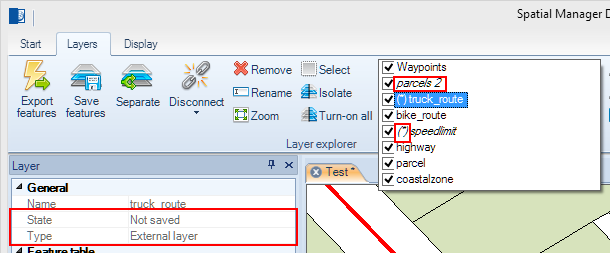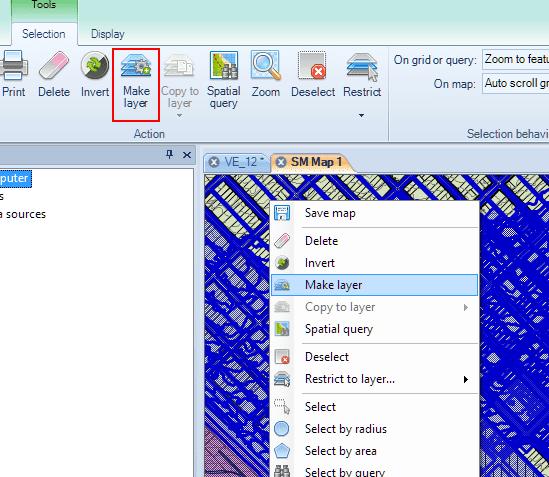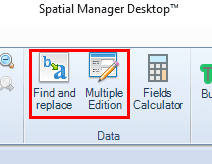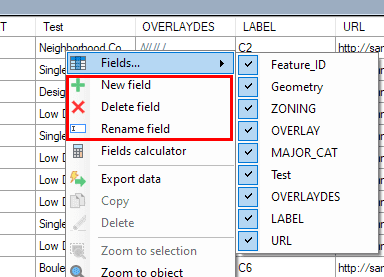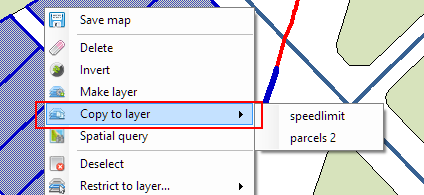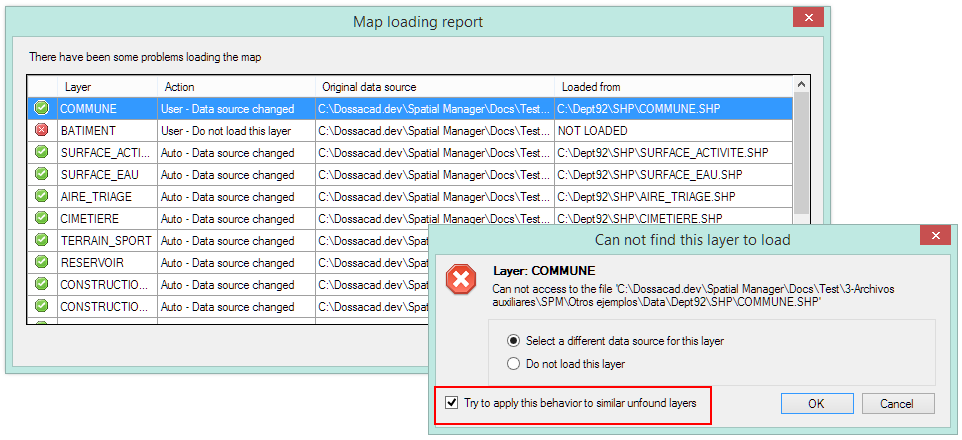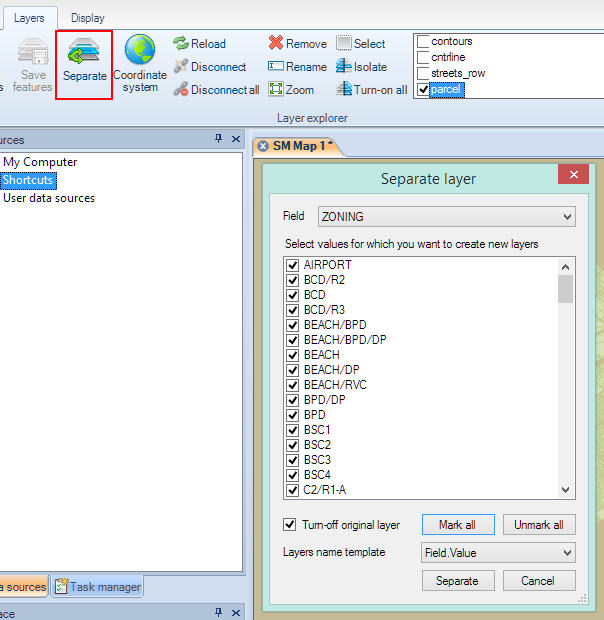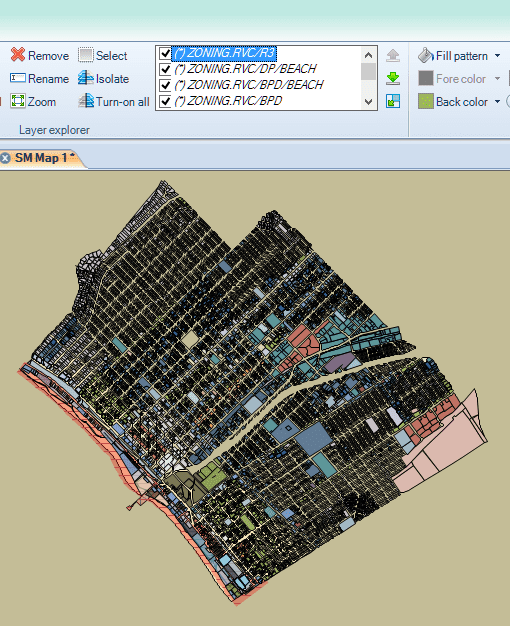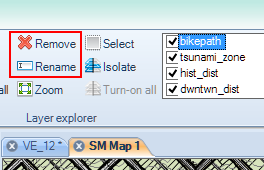Difference between revisions of "Spatial Manager Desktop™ - FAQs: Layer management"
m |
m |
||
| Line 86: | Line 86: | ||
*You can always select a new location for a data source not found (moved or renamed) when loading a Map | *You can always select a new location for a data source not found (moved or renamed) when loading a Map | ||
*You can set the application to perform an automatic search for similar data sources not found (moved or renamed) when loading a Map, and try to find them, based in the following principles: | *You can set the application to perform an automatic search for similar data sources not found (moved or renamed) when loading a Map, and try to find them, based in the following principles: | ||
| − | **Files - when the original path for two files is the same | + | **Files - when the original path for two files is the same and the new data source is: |
| − | ***A file: the application replace the path of the file for that of the new file | + | ***A file in a folder: the application replace the path of the file for that of the new file |
***A file in a Shortcut: the application looks for the file in the selected folder within the new Shortcut | ***A file in a Shortcut: the application looks for the file in the selected folder within the new Shortcut | ||
| − | **Shortcuts - when the original Shortcut for two files is the same | + | **Shortcuts - when the original Shortcut for two files is the same and the new data source is: |
| − | ***A file: for the following cases is taken into account the relative path within the original Shortcut to search for the file in the folders | + | ***A file in a folder: for the following cases is taken into account the relative path within the original Shortcut to search for the file in the folders |
***A file in a Shortcut: the original Shortcut is replaced by the new Shortcut | ***A file in a Shortcut: the original Shortcut is replaced by the new Shortcut | ||
**User Data Sources (UDS): it is only solved if it is selected another UDS | **User Data Sources (UDS): it is only solved if it is selected another UDS | ||
Revision as of 22:43, 2 April 2014
Introduction
- Objective of this section
- To handle new or existing layers and to manage layer storage. To review application automation systems and to try to locate sources not found for Map layers
- Topics in this section
- Renaming and deleting layers
- Making of layers: new layer from a features Selection and editing the structure of the data table
- Adding features to layers: over new layers
- Exporting new layers: definition of the target and its parameters
- Saving modified layers: manually or by closing Maps or the application
- Automating source locations: changing data source locations of a Map
- Separate layers in new layers: for thematic or data discrimination analysis
Which are the types and status for the Layers I can find in a Map of Spatial Manager Desktop™?
In a Map of Spatial Manager Desktop™ you can find these types of Layer (you can view this property in the "Properties" panel when you select a Layer)
- "External Layer": when it is a Layer loaded from an external source (a table from a file, data server, data store, etc.)
- "Embedded in the Map": when the Layer content is located inside the Map (SPM) file. You may note that this type of Layer is in italics in the list of the ribbon "Layers"
- "New": when it is a Layer created in the Map, always by copying Features selected from other Layers, and the Map has not been saved after it is created. It is a special case of "Embedded in the Map" Layers
Note: Creating a new Layer is valid a valid operation even when the selected Features belong to more than one Layer, but be careful because the Data grid of the new Layer will include the Fields of all the Layers in the selection And you can find these status for a Layer
- Considering its saving status (you can view this property in the "Properties" panel when you select a Layer)
- "Saved": when the Layer content is currently saved
- For "External Layers" which means that the Layer content is the same as the content in the external data source
- For "Embedded in the Map" Layers which means that the Layer content is the same as the content in the Map (SPM) file
- "Not saved": when the Layer content is not currently saved. You may note that the Layer name is preceded by an asterisk in the list of the ribbon "Layers", for this type of Layer
- For "External Layers" which means that the Layer content has been modified and it is not the same as the content in the external data source
- For "Embedded in the Map" Layers which means that the Layer content has been modified and it is not the same as the content in the Map (SPM) file
- "Saved": when the Layer content is currently saved
- Considering its editing status
- "Non editable": when the Layer is an "External Layer" and has been loaded from a read-only data source. When you select a "Non editable" Layer you will see all the values grayed in the Data grid because these values cannot be modified
- "Editable": all the other Layers (all "Embedded in the Map" Layers and all "External" Layers loaded from a read and write data source)
How can I change the type or the status of a Layer in Spatial Manager Desktop™?
There are several ways to change the type or the status of a Layer in Spatial Manager Desktop™
- To convert an "External Layer" to an "Embedded in the Map" Layer: you have to use the "Disconnect" function to disconnect one Layer or the "Disconnect all" function to disconnect all the Layers in a Map. You cannot undo these operations so you should avoid saving the original Map. It is recommended to save the modified Map using another name or into another location
- To convert an "Embedded in the Map" Layer to an "External Layer": there is not a direct way to do it but you can "Export" the Features of the Layer to a external table (choosing the best data Provider for you), load this table in the Map and then remove the original Layer
- To "Save" a "Not saved" Layer
- For "External Layers": you have to "Save features", by using this function or by "Saving" the Map
- For "Embedded in the Map" Layers: you have to "Save" the Map
- To convert a "Non editable" Layer to an "Editable" Layer: there is not a direct way to do it but you can "Disconnect" a "Non editable" Layer from its read-only source, or you can select all Features in the Layer and "Make" a New Layer including a copy of the selected objects
How can I edit a Layer, or Features in a Layer, in Spatial Manager Desktop™?
You can edit Features or Layers in Spatial Manager Desktop™ as follows:
- In "Editable" Layers
- "External"
- You can "Delete" selected Features
- You can modify values in any field, directly in the Data grid or using:
- "Find and replace" function, to find and replace values in the Data grid for a Layer
- "Multiple Edition" function, to modify the value for a Field in the Data grid only for a Layer. This function maybe applied to all Features in the Layer or only to selected Features (if any)
- "Embedded in the Map" Layers
- All the above, and
- You can add a copy of the selected Features (if any) to the Layer
- You can "Delete" or "Rename" Fields in the Data grid
- "External"
- In "Non editable" Layers
- There is no way to edit a "Non editable Layer" or its Features. You can "Disconnect" a "Non editable" Layer from its read-only source, or you can select all Features in the Layer and "Make" a new Layer including a copy of the selected objects
Can I change the location or rename the data sources of external Layers in a Map in Spatial Manager Desktop™?
Yes, you can change the location or rename the data sources of external Layers in a Map in Spatial Manager Desktop™, because the application incudes a smart technology to make it easy the steps to find the changed sources of external Layers when loading the Map. This is the way as this technology works:
- You can always select a new location for a data source not found (moved or renamed) when loading a Map
- You can set the application to perform an automatic search for similar data sources not found (moved or renamed) when loading a Map, and try to find them, based in the following principles:
- Files - when the original path for two files is the same and the new data source is:
- A file in a folder: the application replace the path of the file for that of the new file
- A file in a Shortcut: the application looks for the file in the selected folder within the new Shortcut
- Shortcuts - when the original Shortcut for two files is the same and the new data source is:
- A file in a folder: for the following cases is taken into account the relative path within the original Shortcut to search for the file in the folders
- A file in a Shortcut: the original Shortcut is replaced by the new Shortcut
- User Data Sources (UDS): it is only solved if it is selected another UDS
- Files - when the original path for two files is the same and the new data source is:
- The application informs to you, by showing a table including the locations of the found or not found data sources when the loading of the Map is finished. In addition, you can see in this table if the changes of the locations have been performed by the user or automatically by the application
- Finally, the application lets to save the Map, including the new locations found for the data sources
Can I separate a Layer into other Layers for thematic or data discrimination analysis in Spatial Manager Desktop™?
Yes, you can create new Layers from another Layer according to the values of a Field in Spatial Manager Desktop™. To do it, select the Layer to separate and use the "Separate" function in the "Layers" ribbon. You can select a Field of the selected Layer to separate, choose the values in this Field to create new Layers and the template of the new Layers name. You will get a warning about the amount of new Layers to create before continuing with this process. Also, you can turn-off the Layer to separate it in the same process
Can I rename or remove a Layer of a Map in Spatial Manager Desktop™?
Yes, you can rename or remove a Layer of a Map in Spatial Manager Desktop™ by selecting the Layer to rename or remove in the Layer list, and by using any of these functions in the "Layers" ribbon
Related links
- See "Maps, layers, views" also
- Separate thematic Layers from GIS Tables
- Editing ‘Non editable’ Layers
